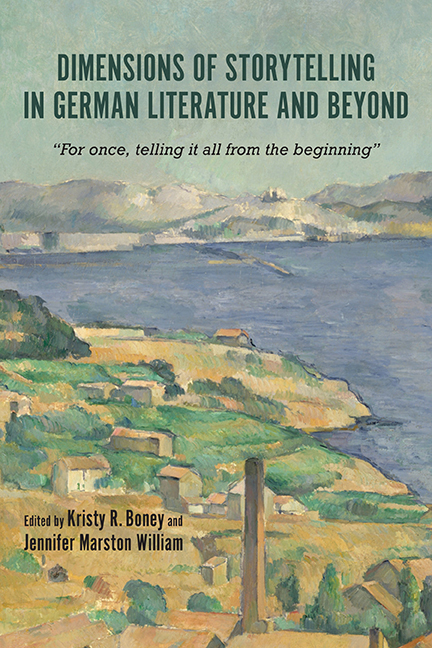 Dimensions of Storytelling in German Literature and Beyond
Dimensions of Storytelling in German Literature and Beyond Book contents
- Frontmatter
- Contents
- Acknowledgments
- Introduction: The Social, Political, and Personal Dimensions of Storytelling
- Part I Anna Seghers: A Missing Piece in the Canon of Modernist Storytellers
- Part II Expressions of Modernity: Using Storytelling Unconventionally
- 8 Storytelling and Telling Stories in Heine's Prose Fiction
- 9 Modernist Haze: Topographical Textures in Paul Klee and Franz Kafka
- 10 Synthesis and Transtextuality: The Jewish Reinvention of Chinese Mythical Stories in “Shanghai Ghetto”
- 11 American Children Writing Yiddish: The Published Anthologies of the Chicago Sholem Aleichem Schools
- 12 A Literary Depiction of the Homeland of Jews in Czechoslovakia and East Germany after 1945
- 13 Changed for the Better? Alternative Uses of the Transformative Cancer Trope in Thomas Mann's Die Betrogene and Nadine Gordimer's Get a Life
- Part III The Personal Narrative: Storytelling in Acute Historical Moments
- Notes on the Contributors
- Index
9 - Modernist Haze: Topographical Textures in Paul Klee and Franz Kafka
from Part II - Expressions of Modernity: Using Storytelling Unconventionally
Published online by Cambridge University Press: 12 April 2019
- Frontmatter
- Contents
- Acknowledgments
- Introduction: The Social, Political, and Personal Dimensions of Storytelling
- Part I Anna Seghers: A Missing Piece in the Canon of Modernist Storytellers
- Part II Expressions of Modernity: Using Storytelling Unconventionally
- 8 Storytelling and Telling Stories in Heine's Prose Fiction
- 9 Modernist Haze: Topographical Textures in Paul Klee and Franz Kafka
- 10 Synthesis and Transtextuality: The Jewish Reinvention of Chinese Mythical Stories in “Shanghai Ghetto”
- 11 American Children Writing Yiddish: The Published Anthologies of the Chicago Sholem Aleichem Schools
- 12 A Literary Depiction of the Homeland of Jews in Czechoslovakia and East Germany after 1945
- 13 Changed for the Better? Alternative Uses of the Transformative Cancer Trope in Thomas Mann's Die Betrogene and Nadine Gordimer's Get a Life
- Part III The Personal Narrative: Storytelling in Acute Historical Moments
- Notes on the Contributors
- Index
Summary
IN MODERNISM the silhouette of a great city usually takes center stage and looms over the individual. Early-twentieth-century social philosophers such as Georg Simmel explored the city as a subject and attempted to explain urbanity through a conceptual system. In his essay “Metropolis and Mental Life” (1903) Simmel claimed that the most difficult challenge of modern life stems from individuals’ attempts to preserve their autonomy in the face of the “intensification of nervous stimulation,” which is the result of the increased tempo of city life. The city becomes a unique place that offers untold potential for the individual; it is the active topography, and it is part and parcel of the modern individual's experience. For example, Mann's account of the decline of Achenbach in a plague-infested Venice conveys an erosion of a stagnated European culture; Joyce's Dublin provides a “photograph” of a city at the turn of the century, and Musil's Vienna offers a quiet urbanity next to Döblin's hectic Berlin. Place names in literature give an immediate entry to the writing. Topography becomes a metonymy of meaning, since it is not pre-existing in itself—it gives solidarity, continuity, and durability to the life that is lived within it. Yet for quintessential modernists Franz Kafka and Paul Klee the topography is less than an urban bustling place for untold potential. Rather, Klee's and Kafka's topographies offer a topographical texture to modernism that visualizes and showcases intricate oscillating processes of emancipation and isolation, as well as connection and estrangement, ultimately marking modernist space.
Kafka's detached visual descriptions help to create the anonymity of the modern experience and allow the reader an illusion of freedom. Indeed, Kafka's stories are incessantly explained as first and foremost fantastic, but other descriptions include prohibitive, tangled, and downright disorderly. The individuals often become barred from or mired in their topography while trying to resolve their conflict. Yet the visual descriptions of topography are as integral to the story as are the characters and plot twists. Without the visual element, one would become as slow and stuck as Kafka's country doctor, who, in trying to escape the sick patient becomes as lethargic as the old man in a snow desert.
- Type
- Chapter
- Information
- Dimensions of Storytelling in German Literature and Beyond“For once, telling it all from the beginning”, pp. 122 - 139Publisher: Boydell & BrewerPrint publication year: 2018
